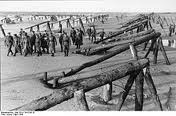Bismarck
Favorite Atlantic Wall Obstacles
-
When I was a kid and started learning about WW2 some 15 years ago, Rommel was my first favorite topic. I always enjoyed looking at all the different types of beach defenses the Germans built. I know I’m a WWII nerd, but while on my job I was driving some steel into the earth for thrust blocking for a pipeline and started thinking about Atlantic Wall obstacles.
-
Morning Worsham. I don’t know where you got those names from: I recognise fewer than half of them. Not sure I can vote yet, sorry!
Who didn’t love reading about Rommel as a child though? -
@wittmann:
Who didn’t love reading about Rommel as a child though?
Most of the items were given nick names by the Gerfmans or Allies, and the names stuck. I must admit a few of the barriers and obstacles I had to search to find a name.
I remember having checked out every book from the school libary having to do with the Civil War, WWI and WWII. The libarian actually started ordering new books to fresh my stock of reading material.
-
@wittmann:
IÂ recognise fewer than half of them.
Ditto. To me, the classic Atlantic Wall obstacles are the ones that look like giant jacks. I think they were made by welding three steel I-beams at right angles to each other. I also have a fondness for the concrete bunkers and casemates that were built along the coast; I got to walk on top of a very small one in Britanny a few years ago. Dragon’s teeth are cool too, but if memory serves they were used on the Siegfried Line rather than as part of the Atlantic Wall.
-
@CWO:
@wittmann:
I� recognise fewer than half of them.
Ditto. To me, the classic Atlantic Wall obstacles are the ones that look like giant jacks. I think they were made by welding three steel I-beams at right angles to each other. I also have a fondness for the concrete bunkers and casemates that were built along the coast; I got to walk on top of a very small one in Britanny a few years ago. Dragon’s teeth are cool too, but if memory serves they were used on the Siegfried Line rather than as part of the Atlantic Wall.
The wielded railroad I-beams were known as Czech Hedgehogs. I would love to visit those bunkers on the Atlantic Coast.
-
@ABWorsham:
I would love to visit those bunkers on the Atlantic Coast.
One interesting place to see if ever you’re over there is the U-boat pen complex in St-Nazaire, which I visited on the same trip:
http://en.wikipedia.org/wiki/Saint-Nazaire_submarine_base
It’s open to the public, and in addition to having access to the inside you can also go up on the roof to see the Fangrost anti-bomb structures which were designed to detonate bombs prematurely (and channel the blast sideways) before they reached the main concrete slab of the roof (which was itself several meters thick). At the time I visited, you could also visit a decommissioned French submarine inside the pen.
-
@ABWorsham:
Most of the items were given nick names by the Gerfmans or Allies, and the names stuck. I must admit a few of the barriers and obstacles I had to search to find a name.
Oh these Gerfmans! lol I like it
I´ll see if I can find some pic´s of the obstacles and will post ´em If you want ABWorsham… -
That would be helpful, Aequitas. Thank you.
-
@aequitas:
@ABWorsham:
Most of the items were given nick names by the Gerfmans or Allies, and the names stuck. I must admit a few of the barriers and obstacles I had to search to find a name.
Oh these Gerfmans! lol I like it
I´ll see if I can find some pic´s of the obstacles and will post ´em If you want ABWorsham…thanks friend. That would be awesome.
-
To the left is a Czech Hedgehog and the other one is a Belgian Gate.
-The Hedgehog was also used as a Tank or Vehicel obstacle on land.
- The Belgian Gate was a water obstacle to hold or slow down boats on a high tide.

-
This picture shows a Rommel Asparagus “Rommel Spargel”, this Obstacle is simple and dangerous.
On top of these Asparagus looking lumber is a Mine deployed and will explode if a boat crossing it. While the Invasion took place at low tide it failed its job to destroy and slow down boats on D-Day but was sometimes used by Snipers to kill the Invaders resting underneath it.
-
Dragon Teeth, German fortifications to ward off the approaching.
Sometimes built with a path through so the Defender could gain access to supply during resting time and easily shoot down the Attacker.Obstruction Beams, similar like the Rommel Asparagus but diffrent in the way of action.
While the Asparagus was intended to hit and sink the boat, the O-Beams were more like to block and destroy.

-
Hairpins are anti tank obstacles buried in the ground to slow down.
-
Thanks for the info and pictures!
-
Awesome pictures.
-
Danke Aequitas.
Must have taken you some time. -
The Tetrahedal a anti Tank obstacle as well.

-
I found the Atlantic Wall construction was created with whatever the Germans could find locally to use. To increase the density of the minefields the Germans used millions of captured French shells. French tanks and tank turrents were used to increse local firepower.
-
@witt Cointet-element is another name for the Belgium Gate that the Belgium Army used in WW2 and the Germans used afterwards. These structures were hard to demolish or move.
Took me awhile to find this subject.
-
@abworsham4 good day my friend.
Never heard that term. Thanks for the update.






